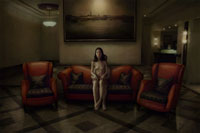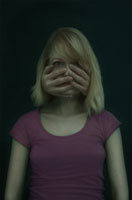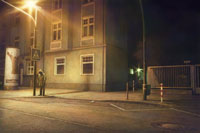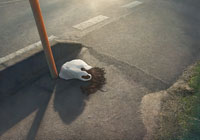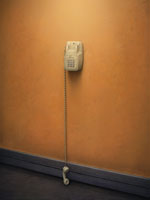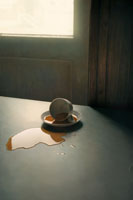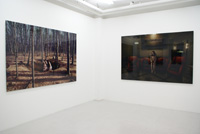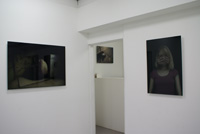佐藤雅晴−写真術に挟まれた絵画術の秘めたる不穏
写真がまだない15世紀のフランドル画家ヤンファンアイクをはじめ、古典的な絵画の目標はリアルに描くことだった。同じころに登場した、イタリアのアルベルティが『絵画論』で語っているように、鏡を並べているように描くこと、そして窓から見える風景を描くこと、あるいは水面に映りこんだ姿を描けることがその理想だった。絵画は目の前の現実であれ、物語化した歴史や空想の産物であれ、まずは鑑賞者にリアルにまざまざと迫真的に見せる技術だった。
この大前提を見事に壊してしまったのが、カメラオブスクーラ(暗室)という形で、画家のそばで絵画に寄り添うようにして成長してきた写真の技術であった。写真技術の完成度が上がることで、絵画はリアルに描くことを理想としなくなり、目に見える現実とその迫真性で現実と対抗することはなくなった。これが起こったのが19世紀のことで、それ以降、絵画独自の言語を追求する技術へと進化した。それがモダニズム絵画である。以降、現実世界や目に見えるものは手がかりとはなっても目的とはならず、絵画は独自の言語や語彙という形を分析的に作り出すことで、今まで進化してきた。写真も同様に、一ジャンルとして確立する。
絵画と写真が並び立つ時代にあって、佐藤雅晴のように緻密に写真のように描くことにどのような意味があるだろうか。モダニズム絵画以降の時代にあっても、例えば「スーパーリアリズム」といった言葉で、話題を提供し続けてきた。いつの時代にあっても、リアリズムの技術は驚異なのだ。
ただ、佐藤の場合が少し独特なのは、セッティングの上、撮影されたリアルな情景をベースに、コンピュータ内のことであれ、筆のタッチを用いて絵画としていったん描かれていく、ということだろう。そして最後に写真と同様に高品質に印刷される。つまり、彼の制作プロセスは基本的に撮影−描画−印刷である。このプロセスをコンピュータグラフィックスと言ってしまえば、それまでのことだが、CGという言葉が一般的に与える幻想とは違い、その幻想は、現場の写真を出発点としているために現実の空間性に深く根ざしている。同時に印刷を終着点としているために、これが写真で捉えられた客体としての現実であるという誤解を促すのだ。
佐藤の作品を見れば、事件や人物のリアル感や存在感を描出するには、絵画に根ざす技術が写真の技術よりもまだ有効であることは明白だろう。単にCGというだけではここまでリアルにはならない。つまり、写真以前に進化していた絵画の方がリアルな表現にはまだ優れていたのである。むしろ、彼の作品と通して明らかになってしまったのは、写真術に慣らされた我々の薄っぺらなリアル感だろうか。あるいは写真が持っている鑑賞者との心理的な距離感とその安心感。写真が通常示してくる現実感と、彼が絵画を経由して作り出す強い幻想の間で、佐藤の作品を見る我々は混乱してしまう。鑑賞者を見つめかえす主人公たちの姿は我々をさらに不安にさせる。
彼の大作はとりわけ不穏である。設定され編集された情景の不穏さもあるが、それ以上に、絵画術本来の不穏さもあるだろう。絵画は、幻想が投影されるスクリーンなどではなく、見えている、あるいは見えるはず、そして見えていないが見えるものを構造的に支えている世界までを、過剰なまでに鑑賞者に突きつけてくるのだ。
こうして、写真にはない、絵画術によって細密化された現実の不穏さが、客体としての写真の姿で鑑賞者を脅かし続ける。「我々はイメージや幻想なんかではないのだ。肉体なのだ」と。
これが佐藤雅晴の作品の魅力であり、怖さでもある。
拝戸 雅彦/愛知県美術館学芸員
Copyright(C) 1998-2005. Gallery Jin all rights reserved.
このサイト及びサイト上の内容を無断で複製、転載、使用することを禁じます。
Masaharu Sato:
The Hidden Disquietude of Painting Caught within Photography
Masahiko Haito, Curator, Aichi Prefectural Museum of Art
Before photography was invented, the goal of classical painters, such as 15th-century Flemish painter Jan van Eyck, was to depict actual scenes as realistically as possible. As is indicated in the treatise On Painting (which was written by an Italian author Lean Battista Alberti, who appeared around that same period), creating an ideal painting meant to portray a scene as if seeing a line of mirrors, and to create a scene as if seen from a window, or else to depict the appearance as reflected on a water surface. Primarily, painting was considered to be a technique that realistically and vividly showed viewers images, whether it was a painting of an actual scene or a historical story, or a painting that derived from one’s imagination.
This great precondition of painting was demolished by the appearance of the camera obscura. Photographic techniques were then developed alongside the medium of painting, and have always remained close to painters. When photographic techniques reached a high degree of perfection, realistically depicted paintings were no longer seen as being ideal. Thus, painters stopped vying with the actual, existing scenes with which they depicted the realities visible to their eyes while also conveying their sense of vividness. This mostly took place in the 19th century. From that time, practitioners of painting began evolving toward devising techniques through which they could pursue the medium’s own unique language. This led to what would be called Modernist paintings. Hereafter, the real world and visible scenes provided hints to painters, but capturing reality was no longer seen as the sole purpose of painting. Thus, this medium has continued to evolve up to the present-day through analytically originating its own forms of language and vocabulary. At the same time, photography similarly grew to establish itself as one of the essential genres in art.
In an age when painting and photography are seen as equal in value, what can be the underlying reason for artists such as Masaharu Sato to elaborately depict works that can be mistaken for photos? Even after the period of Modernist paintings, realistic depictions, under such terms as “Super-Realism,” have continued to gain people’s attention. Throughout every age, the techniques of realism have continued to amaze people.
However, a rather unique point about Sato is that through the touches of his “brushstrokes,” he depicts a painting over the actual scene he has photographed, even though this is all done on a computer. As his final process, he prints out the work in high quality, in the same way that he would print out a photo. In other words, the basic production process he undertakes is: to photograph, to depict, and then to print. One could simply dismiss Sato’s method by saying that overall process is nothing other than “computer graphics.” But different from the illusion that the term “CG” generally conveys, the illusion that Sato’s works presents is deeply rooted in actual spaces, due to his starting out from using photos of existing sites. But because the final process he undertakes is printing, viewers are also led to misunderstand that the scene is a real one with objects captured in a photo.
Viewing Sato’s works allow us to clearly understand that in order to reveal a sense of reality or existence from an incident or a person, the techniques that derived from painting are still more effective than photographic techniques. Computer graphics alone are unable to convey the extent of Sato’s realistic expressions. In other words, his works demonstrate that painting, which was developed earlier than photography, still excels in conveying reality. Thus, Sato’s works result in revealing our own frivolous sense of reality, caused by our growing too accustomed to photography. This can also be described as the sense of security we feel toward photos, due to the psychological sense of distance that is provided by photography. That is why viewing Sato’s works confuses us, in that we are placed in between sensing reality, which is normally conveyed from photos, and perceiving a strong sense of illusion, which he has created through the process of painting over a photo. The main characters in his works that gaze back at us make us feel even more insecure.
Sato’s large-scale works are particularly disquieting. This feeling is perceived from the settings and the edited scenes of his works, but a more disquieting element is inherently possessed by traditional painting techniques themselves. His “painting” works are nothing like screens that project illusions; rather, they overly compel viewers to gaze into the world of his works, which are structurally supported by the visible images, the elements that become visible upon closer look, and even by the undetectable but perceivable matters that all exist in his works.
In such a way, the disquieting realities that have been refined through Sato’s painting techniques, which are nonexistent in photography, continue to frighten the viewers in the forms of objects that are clad in photographic figures. His works seem to be saying, “We are no such things as images or illusions: we are physical beings.”
This notion explains why Masaharu Sato’s works are so appealing yet so frightening.
(Translated by Taeko Nanpei)
Copyright(C) 1998-2005. Gallery Jin all rights reserved.

